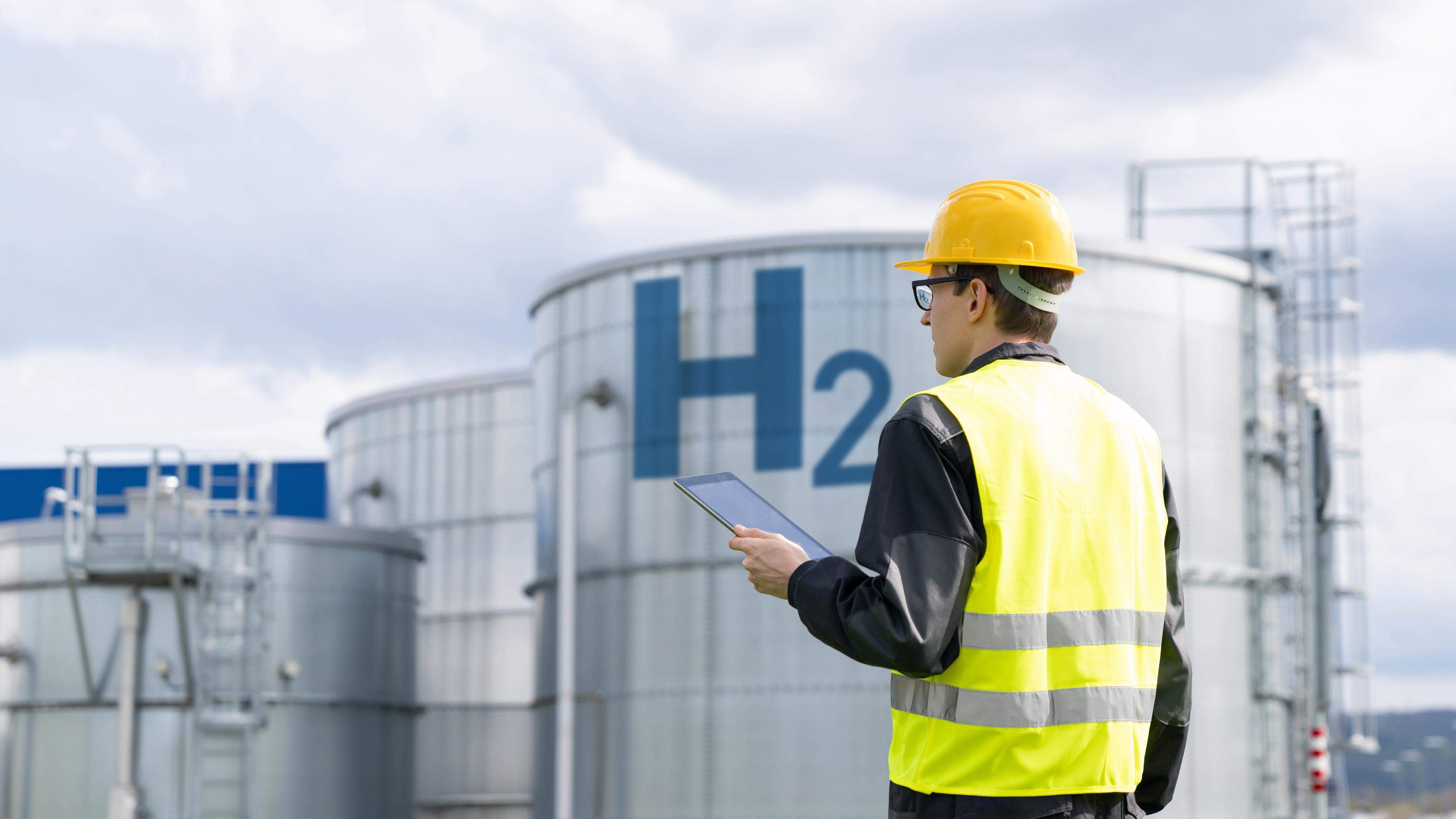So hydrogen comes to Luxembourg as an alternative to fossil energies

If Luxembourg wants to achieve its ambitious climate goals, the companies in the country have to reduce the use of fossil energy. A key role can play hydrogen. According to the strategy of the Ministry of Economic Affairs, the use of hydrogen, the decarbonization of the heavy industry in the south of the country and the transport sector on land and in the future should enable them in the air.
Luxembourg decides on the law to promote hydrogen projects
Pit Losch, the hydrogen expert of the Ministry of Economic Affairs, explains that « the hydrogen used in the industry must consist of green hydrogen to 42 percent by 2030. »
The hydrogen law adopted in March is intended to form the basis for the hydrogen economy in Luxembourg. In the future, the gas should also be used as energy storage if there is an oversupply of electricity from renewable sources. The excess electricity can be converted into hydrogen and « imposed » again if necessary.
In industry, the hydrogen used must consist of green hydrogen to 42 percent by 2030
Pit losch
Hydrogen expert of the Ministry of Economic Affairs
« Energy transition is not only under the sign of protecting the climate, but also to become more independent by countries that have exported fossil energies in the nearby, » reports Pit Losch. He adds that « at the beginning of the Russian attack war fossil hydrogen was temporarily more expensive than green hydrogen ».
Appendix to the production of hydrogen in Luxembourg planned
Green hydrogen is generated by the electrolysis of water using renewable energies. The decision as to whether green hydrogen will also be produced in Luxembourg will be produced in the future in May. If the Ministry of Economic Affairs approves of promoting the « Luxembourg Hydrogen Valley » project, the energy supplier Enovos will check the purchase of an electrolyser in the southwest of the country. The LuxhyvalProject wants to establish a hydrogen value chain. Participants should be able to gain initial experience with the new technology.
Hydrogen gas is currently being used in industrial processes in Luxembourg, for example to win tungsten. The gas currently comes from fossil sources and is therefore referred to as gray. « The manufacturing process is quite resistant to CO₂. Nine to twelve kilograms of carbon dioxide are released per kilogram of hydrogen, » reports Yves Reuter, project manager at Enovos.
Yves Reuter plans to produce green hydrogen in Luxembourg. Photo: Enovos
In contrast to natural gas-based extraction, the planned 5-megawatt system is to produce green hydrogen from 2027 by splitting water molecules into the components of oxygen and hydrogen with renewable energy. This could produce one to two tons of hydrogen per day.
In the specific case, the electricity for the electrolyser must also come from the region so that the form of hydrogen can be described as « green », in the specific case from Germany or Luxembourg. A hurdle in the production of green hydrogen is the area on which the sustainable current is to be generated, according to the project manager. « Existing capacities should not be withdrawn from the market. In the future, the renewables should be built especially for the green hydrogen, » says Reuter.
Versatile applications
In addition to direct use in industrial processes, the energy source obtained in this way, green hydrogen, can also replace fuels in addition to direct use in industrial processes. The gas can also be used to decarbonize local public transport in Luxembourg or heavy goods traffic.
In addition to heat, the climate -neutral product of water is created when the hydrogen is burned. Yves Reuter explains that « it is still very difficult to replace natural gas with hydrogen nowadays. Hydrogen is simply much more expensive than natural gas. Technically, it would be possible in many cases. »
Days of the diesel bus apparently counted
In addition to hydrogen, oxygen and heat also arise in the process of electrolysis. One could use one of these two products, for example to heat a swimming pool. So the profitability of an electrolyser could be increased. However, the use of these two products is not yet economical in Luxembourg because the planned pilot plant is not large enough.
Green hydrogen can also serve as an energy storage by stored excess renewable energy by electrolysis in hydrogen. If necessary, fuel cells can generate electrical current again. This conversion enables stable energy supply, especially in times of fluctuating generation through renewable energies.
The dependence on the sun and wind
Since green hydrogen has to come from renewable sources after EU definition, this inevitably leads to a complete dependence on wind and sun. As a result, production fluctuates, while the demand for green hydrogen in industry will remain constant.
There will definitely be times when a lot of electricity and therefore a lot of hydrogen are available.
Yves Reuter
Senior project manager at Enovos
This problem can solve storage capacities. Either by storing the energy itself or switching a battery in front of the electrolyser. « There will definitely be times in which a lot of electricity and therefore a lot of hydrogen are available. On the other hand, there will also be more moments when we do not produce anything and the customers are needed. You can only solve this with saving, » concludes the engineer Reuter.
By 2050, green hydrogen is to fully supply industry
Yves Reuter suspects that « hydrogen production on a small scale will not necessarily be economical in the long term ». For this reason, it is planned to connect Luxembourg to an international hydrogen network, similar to how it exists for natural gas.
Hydrogen nets and the associated import options form an alternative that minimize the dependence on the sun and wind and enable continuous delivery and a stable market price.
European hydrogen network enables more flexibility
« Luxembourg will definitely be an import country for hydrogen. We do not have enough renewable energy to cover the national hydrogen requirement, » said Jean-François Schneider from the hydrogen department at Creos. The planned connection to the so-called European « hydrogen backbone » focuses on the supply of the heavy industry in Luxembourg and the transport sector with hydrogen.
Luxembourg will definitely be an import country for hydrogen.
Jean-François Schneiders
Hydrogen department of the Creos
It is about building a hydrogen network in the region around the Grand Duchy. The network is part of the EU strategy to transport hydrogen similar to electricity and natural gas on the European continent. The infrastructure is intended to form the backbone for the energy transition in Europe using hydrogen technologies, hence the naming « Hydrogen Backbone ».
Study: initially important for hydrogen supply
In two phases, the connection to the European hydrogen network is to be paved for sustainable industrial use of hydrogen in Luxembourg. « In the first phase, a pipeline from France offers industries around Esch and Differdingen the opportunity to be supplied with hydrogen and to promote the decarbonization of the Luxembourg industry, » says Schneiders, who says the project « Hy4link« Responsible. He adds that » a second connection to Belgium green hydrogen, which comes from the North Sea, is supposed to integrate into the Luxembourg hydrogen network « .
« The expansion of interconnectors between European member states is desirable because energies are shared across borders, used directly and not have to be stored locally, » explains Losch.
Jean-François Schneider wants to import green hydrogen via a European pipeline network. Photo: Creos
In contrast to the power grid, the hydrogen network with flexible loads can, for example, have a certain memory effect between 30 and 40 bar. « Unlike the electricity, where withdrawal and feeding must be compensated for to ensure a frequency of 50 Hz, a large-scale gas network-similar to natural gas-allows higher tolerances, » explains Jean-François Schneiders.
Natural gas is significantly cheaper than hydrogen
« Today’s hydrogen prices are currently breaking out industry, » says Schneiders. In order for the sustainable gas to compete with fossil natural gas, the prices for green hydrogen would have to align fossil sources such as natural gas over the next 25 years. If the framework conditions change by promoting the currently cheap CO₂ certificates more expensive or the hydrogen prices at European level, this could accelerate technical progress.
In order to reduce the price difference, paths are to be found to get less expensive hydrogen. In addition, the Luxembourg state analyzes « projects in water and energetic regions in the world, where you can produce cheap and a lot of hydrogen, for the purpose of exporting towards Europe in general and Luxembourg in particular, » explains Pit Losch.
Pit losch Photo: Ministry of Economic Affairs
Up to 820 tons of hydrogen per day
According to current estimates, four to ten terawatt hours of hydrogen are required by 2050, so that the need from heavy industry, transport and in the future as a memory can also be covered in the industrial die. The energy requirement thus corresponds to about 330 to 820 tons of hydrogen per day; In comparison, loud CEIC The Luxembourg state imported over 6,000 tons of oil products per day in 2022.
It remains to be seen when the economy for green hydrogen is reached. However, it is certain that the day on which sustainable technologies compared to the use of fossil energies must not only be ecologically but also economically sensible within the next two decades if European governments are still aiming for decarbonization by 2050.







